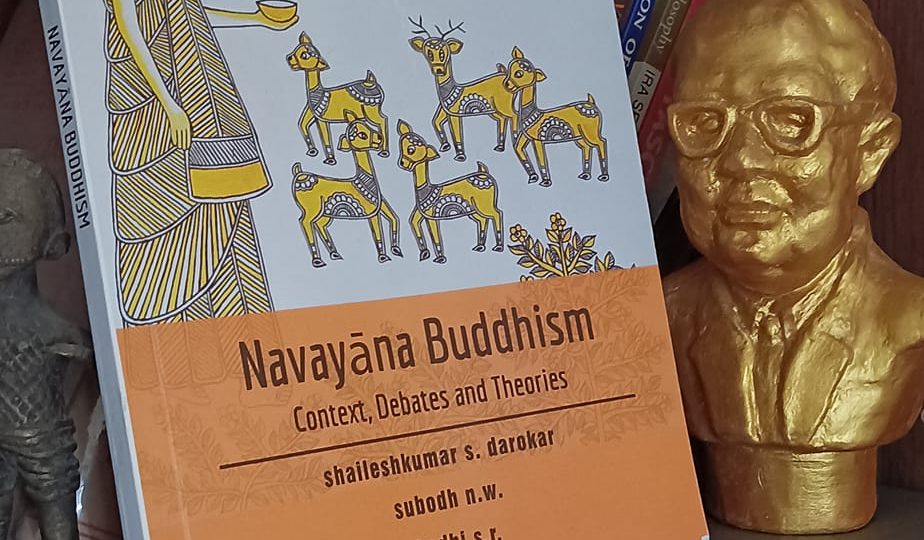Dr. Anuradha Bele
Navayana Buddhism – Context, Debates and Theories by Shaileshkumar Darokar, Subodh N.W. and Bodhi S.R: The Shared Mirror Publishing House, 2022, ISBN: 9788192993058 (Paperback) pp.vi to 120, INR 250.
Navayana Buddhism – Context, Debates and Theories, is a 120 page book that engages with a path crafted by Dr. Ambedkar within the framework of Buddhism in the year 1956. The foreword has been written by Santosh Raut, and the Cover Page Artwork is a beautiful painting by Malvika Raj. This book is in fact not a book; it is the taste of the Dhamma itself. It touches upon the struggle and the strategies used by the followers of Dr. Ambedkar to free their minds from historical dehumanisation, pain and suffering. A key point that the book brings to bear is the argument posited by Dr. Ambedkar, that the people who were ostracised and forced into untouchability by Savarnas, were actually the erstwhile Buddhists who have, through millenniums, defied all odds and held steadfast to the teachings of the Buddha at the cost of dehumanisation, caste slavery and untouchability. This concrete condition of social exclusion persisted till Dr. Ambedkar arose and revived people’s collective memories by providing them a Navayana path that unravels this historical truth and in the process set them on the path of freedom from the burden of historical subjugation and mental slavery.
Sourced from the experiences and teachings of the Buddha about 2566 years ago and contextualised to the Indian context by Dr. Ambedkar, the book is divided into five chapters. Beginning with an excellent preface that traces the historical struggle of the Ambedkarite movement, the first chapter discusses the context and reasons that led Dr. Ambedkar to embrace Buddhism. The second chapter is a detailed analysis of empirical data of the Buddhist movement from the perspective of practitioners in retrospect. The third chapter enters the domain of Buddhist theory from within the Navayana framework touching upon the idea of what taking refuge in the Buddha-Dhamma-Sangha entails. The fourth chapter is discursive, in the sense that it unravels the details of the Ambedkarite project of epistemological reconstruction. The last chapter explains the Navayana framework concerning Dr. Ambedkar’s framing of the Buddhist Way of Life for the followers of the Buddha in India.
The first section of the book titled Contextualisation, lays down a framework in the context of the Indian reality with a summary of the historical debates, and then moves on to the views of the practitioners, with a glimpse of the complexities, and varied experiences and perceptions of practitioners. Starting with Babasaheb’s paradigm shifting 22 vows, which restored morality as the founding principle of human life, the book leads us to the current state of the conflict, which is now contested around methodology. After Dr. Ambedkar’s demise, all those who identified with the ostracization by the dominant caste society came under the umbrella of the hugely powerful and energetic term, Dalit. This term came to be associated with political action by a group as well as behavioural attributes of an individual committed to a fundamental structural change grounded in liberty, equality and fraternity that Dr. Ambedkar sourced from his Master, the Buddha. The Dalit movement evolved into the ground-breaking Bahujan category which though apparently political, made visible, a space in which the mind itself is a construct of power. Further historicization and contextualization led to the category Mulnivasi that explains the historical roots of the shared experiences of the various castes and communities. All these, it is argued by the authors, are now defining a ‘Methodology of Life and Living’ itself, grounded in an alternative conception of what Buddhists define as ethical and valuable. This approach was located by Dr. Ambedkar himself around a historical framework conceived around the Buddha-Dhamma-Sangha as propounded by Sakyamuni. He called this the ‘New-Vehicle’ or the ‘Nava-Yāna.’
The second section of the book, titled Equanimous Reflections, contains the Dhamma dialogues of the Navayana Buddhist Sangha, which carry with them an aroma of the Dialogues at Isipatana and Shravasti. When an individual deepens one’s experience of life, and reflecting upon it, starting with the process of the observation of mind, body, sensation and dhamma (universal law), all constructs, including the mind, used in the meaning-making process are revealed and the individual is free. Yet epistemology remains at the heart of Buddhism, grounded in Pradnya, Karuna, and Samata. The following chapters examine and unravel each concept laid down in Buddhism. As exhorted by Dr. Ambedkar in the Preface of ‘The Buddha and His Dhamma’ to cleanse Buddha’s teachings, the subsequent discussions seek to not just evaluate, but also to redefine the current perspectives within Buddhist discourse. Ultimately, the Authors move towards ‘The Buddhist Way of Life’ in which 27 paragraphs of Dr. Ambedkar’s text are condensed, and his emphasis and embodiment of walking the Buddhist path are underscored.
In the contemporary tussle to thrust upon an Indian populace a Buddhism that is difficult to relate to, this book stands out quite simply, as the ‘truth’. Buddhism has permeated and enriched all lands it has journeyed to; it has made the people more rational and humane. The Indian context has produced this exquisite school of Navayana Buddhism as its tool of emancipation. The Navayana path is in accord with science, is fundamentally grounded in the principles of liberty, equality, and fraternity, and does not sanctify or ennoble poverty and suffering. It shows a path to a life which holds dearly to self-respect and dignity in which individual freedom, public morality, and social mobility is embodied, realized and practiced.
Like Dr. Ambedkar’s ‘The Buddha and His Dhamma,’ this book – Navayana Buddhism – Context, Debates and Theories is a text which should reach every household committed to the vision of the cultivation of the mind. It needs to be read, re-read and debated by every Buddhist all around the world and celebrated as the coming of age of the Wheel of Dhamma set in motion a long time ago. This book is for those serious in their pursuit of the Buddhist path, who want to move beyond the individualistic, dogmatic asset-stripped form of Buddhism and recapture its holistic, wholesome essence.
(This review appeared in Ambedkar, Buddhism and Social Transformation, July-September 2022 issue of Social Action Journal, Indian Social Institute, New Delhi)
~~~
Dr. Anuradha Bele is an electronics engineer and a veterinary doctor with a degree in management. She can be reached at anuradha.bele@gmail.com
Picture courtesy: Naren Bedide (Kuffir)










